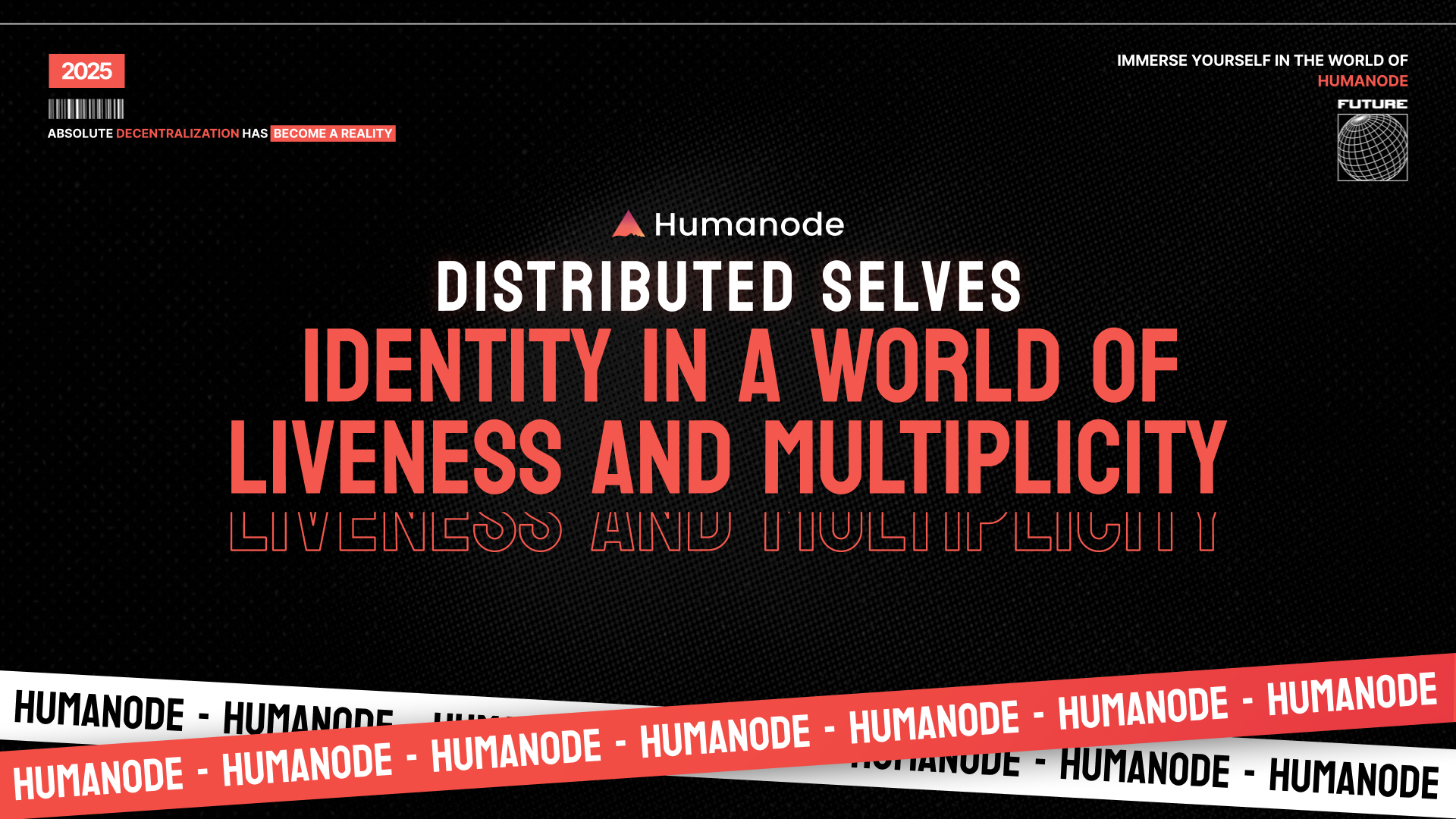Distributed Selves: Identity in a World of Liveness and Multiplicity

By Sasha Shilina
“The self is not something ready-made, but something in continuous formation through choice of action.”
— John Dewey, Human Nature and Conduct (1922)
I. Introduction: The Blink That Proves You Exist
In a world governed by algorithms, the ability to verify that one is alive, through a facial gesture, a blink, or a pulse, is becoming a new foundation of trust. Biometric liveness detection promises a post-password world: systems that can distinguish real humans from bots, deepfakes, or duplicated identities.
Humanode takes this promise seriously. In a sea of Sybils, where wallets can be spun endlessly and token economies gamed by scripts, Humanode anchors participation to biometric uniqueness. Through privacy-preserving facial liveness checks, the system ensures that each node is tied to one unique, living person.
But beneath this technical elegance lies a deeper question: What does it mean to be alive (philosophically, psychologically, politically) in a system that verifies liveness, but not selfhood?
Can a blink prove existence? Can a face certify identity? Can protocols built for bodies account for the multiplicity of the self?
II. Liveness as Ontological Threshold
Liveness detection, in its technical sense, is binary: the system checks for subtle signs of presence, eye movement, skin texture, micro-expressions, and returns a result. You are live or you are not. But philosophically, liveness is not a switch. It is a spectrum, a becoming, a negotiation of attention, agency, and meaning.
Martin Heidegger distinguished between mere biological life (zoē) and being-in-the-world (Dasein), the latter defined by care, projection, and the ability to ask who one is [3]. A liveness check captures the former. It proves that you are present biologically, but it cannot know what you are present as.
In that gap lies an ontological risk: We are designing systems that verify the body, but not the being.
This risk is not new. Giorgio Agamben’s concept of bare life, life that is biologically present but politically unrecognized, haunts biometric systems [4]. When liveness becomes the minimal requirement for participation, we risk reducing humans to the threshold of vitality, stripped of their symbolic, cultural, or psychological complexity.
To be alive is not to be whole.
III. The Fragmented Self and Protocolal Identity
Contemporary psychology and poststructuralist thought emphasize that identity is not singular or stable. The self is distributed, performative, and often contradictory. As Judith Butler argues, identity is an act: a repetition of gestures, codes, and norms that congeal into the illusion of stability [1]. In digital life, this is even more pronounced. We are multiples, one self for work, one for the DAO, one for the burner wallet, one for the meme alt.
So what happens when a protocol assumes you are one person, tied to one biometric body, with one persistent identity?
Even systems like Humanode, which preserve pseudonymity and avoid biometric storage, still enforce a logic of singular personhood. One node per person. One validator. One vote.
But what if the self is plural by nature?
- What if you are both artist and engineer, lover and researcher, DAO governor and saboteur?
- What if your internal multiplicity exceeds the external container of your liveness template?
Protocols designed for uniqueness may inadvertently flatten the self, collapsing complexity into compliance.
IV. The Politics of Recognition in Biometric Systems
There is also a political danger. Biometric systems, even those designed for privacy, establish new boundaries of inclusion. They define who can be seen by the machine, who is granted personhood in protocol space. Those whose faces are unrecognized (due to disability, age, trauma, or aesthetic divergence) may be rendered machine-invisible.
Moreover, by verifying the fact of life, these systems risk ignoring the conditions of life: precarity, care, solidarity, and struggle. As Simone Browne has shown in her work on surveillance and race, biometric systems often reproduce the exclusions they claim to overcome [2]. The machine may accept your face, but does it recognize your personhood?
In a truly democratic system, verification must go beyond presence. It must make room for difference, opacity, and even incoherence, the things that make us human, not just biological.
V. Toward Distributed Identity and Ethical Liveness
So what would a more nuanced model look like?
- Identity as MultiplicitySystems could allow users to maintain multiple selves under one verified existence, enabling context-sensitive personas while still protecting against Sybil attacks.
- Liveness as Process, Not GateInstead of using liveness as a static pass/fail filter, it could be treated as a dynamic condition, one that evolves over time, integrates reputation, participation, and voluntary re-verification.
- Recognition Beyond the FaceFuture systems might verify presence through more than just biometrics, integrating relationality, contribution, and consent as components of what it means to be “here.”
- Protocol HumilityNo system should claim to define what it means to be a person. At best, it should create a space for persons to appear, act, and disagree.
VI. I Blink, Therefore I Am?
Liveness detection may protect systems from fraud, but it cannot protect us from reduction. It can verify that we are alive, but not who we are, what we mean, or what we might become.
To build identity protocols for the future, we must design not just for security, but for selfhood, in all its messy, shifting, and contradictory dimensions.
Because in the end, the goal is not just to prove that we are here. The goal is to build systems where we can become more than we are, without leaving parts of ourselves behind.
References
- Butler, J. (1990). Gender Trouble: Feminism and the Subversion of Identity. Routledge.
- Browne, S. (2015). Dark Matters: On the Surveillance of Blackness. Duke University Press.
- Heidegger, M. (1962). Being and Time (J. Macquarrie & E. Robinson, Trans.). Harper & Row. (Original work published 1927)
Agamben, G. (1998). Homo Sacer: Sovereign Power and Bare Life. Stanford University Press.

